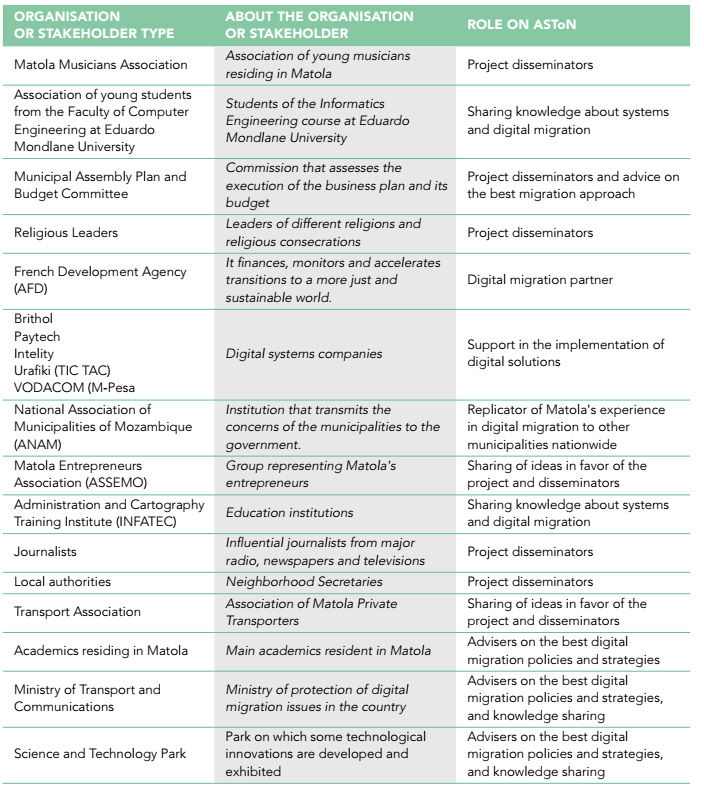Tax collection
Focus area for ASToN
 Matola’s chosen theme is Tax collection
Matola’s chosen theme is Tax collection
The key issue identified within Matola is that insufficient tax is collected from citizens, which impacts the municipality’s ability to deliver other essential services. Current tax collection systems are not effective, and many citizens and businesses avoid paying their taxes. Unfortunately, the council isn’t always able to hold people to account for this as they don’t have robust data on who is eligible for tax.
The vast majority of tax collection is done manually, and relies on citizens attending in person at tax collection points. However, citizens often do not know that they are required to pay taxes or how to pay their tax, as the system is complicated.
While the existing online tax system aims to reduce the burden on both citizens and administration, it only covers two taxes so far. The big problem is that the citizens choose to pay most of their taxes in person, at their bank or tax collection point.
A potential way to measure the success of digital projects for this issue would be by an increase in tax revenue, as well as utilization of the online tax collection service.
Findings: the starting point for addressing these problems
The following findings set out the starting point for Matola as they work to address tax collection. Based on research conducted over the course of Phase 1, they describe the interlinked strengths and challenges that need to be taken into account.
There is a massive opportunity for generating revenue through tax collection that the CMCM is already building towards
While the strengthening of fiscal tribunals shows stronger enforcement of tax collection in recent years, there is still a massive opportunity in Matola to increase tax revenue based on a lack of information on tax collection more generally. As many as 500,000 citizens are potentially eligible for tax and the service distance between them could be shortened using digital tools. Digitalisation of tax revenue systems has already begun, so shows promising room for growth.
The citizens of Matola may be hard to reach as they have low literacy, are resistant to change, and often cannot afford to access the internet
There is high illiteracy and digital illiteracy among the population of Matola, and an observed resistance to change from existing practices. This means that the online tax system has had somewhat limited usage. High internet coverage is also not reflected by internet access for a significant proportion of the population.
For the city council there is a significant risk posed by the lack of key data and digital infrastructure, as well as limited human resources
The municipality lacks complete data on city addresses and a property registry. There is too a lack of clarity about how to define the value of a building for tax purposes. Furthermore, when it comes to revenue collection, the digital infrastructure surrounding collection points today is weak (including connectivity and acquisition of a server), and there are insufficient internal human resources for providing and monitoring the revenue collection service. Finally, there is a lack of human resources and materials held by city authority staff in how to reach out to more marginalized groups.
While the city council has low internal digital capacity they have experience working with external actors and service providers
There is both a lack of capability and confidence from many of the council staff in their ability to manage a digital project. Additionally, there are few computers and low internet connectivity in the CMCM offices. The local authority has worked with these facts by partnering closely with external providers to conduct digital projects and manage data.
Significant devolution of power to the city councils means there is insufficient information sharing or alignment with national government
The devolution of power from national government to local authorities has meant that there is a lack of data sharing between different types of government actors. This also means that there is potential for the municipality to create a tax system that isn’t integrated with national tax protocols. Finally, while inter-municipal communication is strong, there is no integrated tax system across the province.
Next steps
The ASToN project is seen as providing tools and assisting in the identification of the mechanisms and means to complete a digital transformation plan for Matola.
With the e-Tax website already up and many plans already underway, the main focus of the ASToN project is still being defined.
Departments of the authority involved in the project

Stakeholders involved in the ASToN Local Group

Participating in the ASToN network



